Key takeaways:
- The manuscript submission process involves selecting the right journal, preparing the manuscript according to specific guidelines, and writing a compelling cover letter, all of which require careful attention to detail.
- Responding to peer reviews should be approached with respect and gratitude, viewing critiques as opportunities for growth and improvement rather than personal attacks.
- Managing the publication timeline necessitates planning, patience, and proactive communication with journals to alleviate anxiety and maintain engagement throughout the submission process.
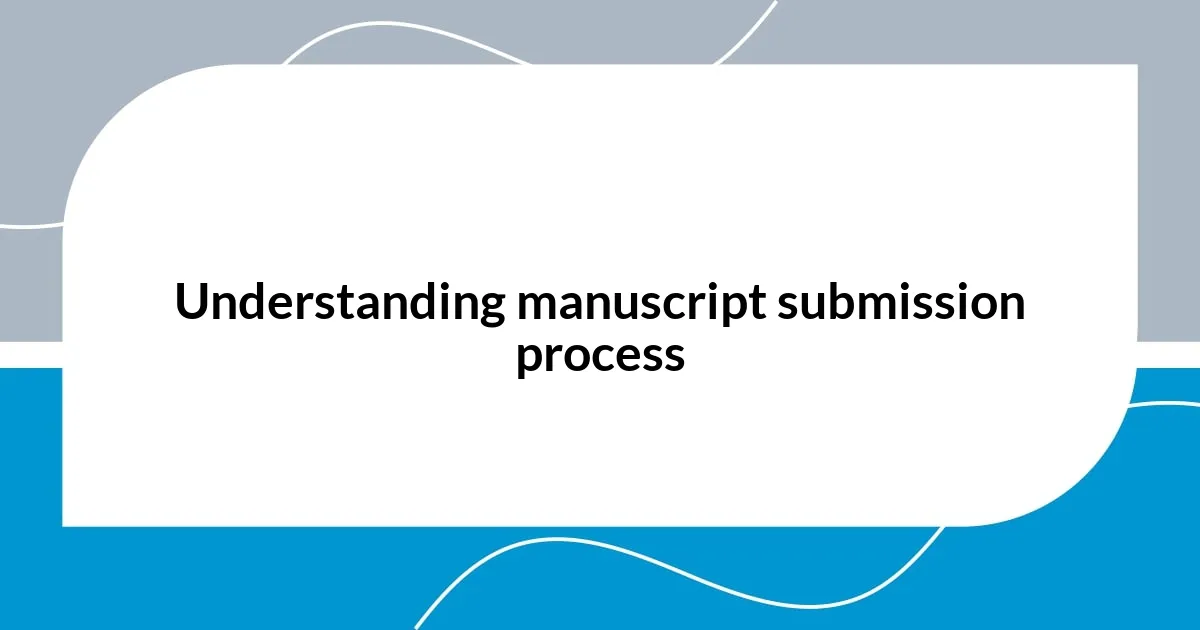
Understanding manuscript submission process
Submitting a manuscript can feel like preparing for a big exam. I remember staring at my computer screen, wondering if my work was truly ready for outside eyes. The submission process often begins with selecting the right journal, which can be daunting, especially when considering factors like the journal’s focus, audience, and acceptance rates.
As I went through the checklist of requirements for my first submission, I felt a mix of excitement and anxiety. Each guideline felt like another hurdle, from formatting the document to crafting a compelling cover letter. I often asked myself, “Am I really conveying the significance of my work?” This sweet pressure can fuel motivation, helping refine your manuscript into the best version it can be.
Once I finally hit “submit,” there was an exhilarating rush of relief followed by an aching sense of vulnerability. It’s like sending your child off to school for the first time; you hope they’re ready and just waiting for their chance to shine. That moment taught me that the submission process is not just about the manuscript; it’s about self-discovery and understanding the value of my voice in the academic conversation.
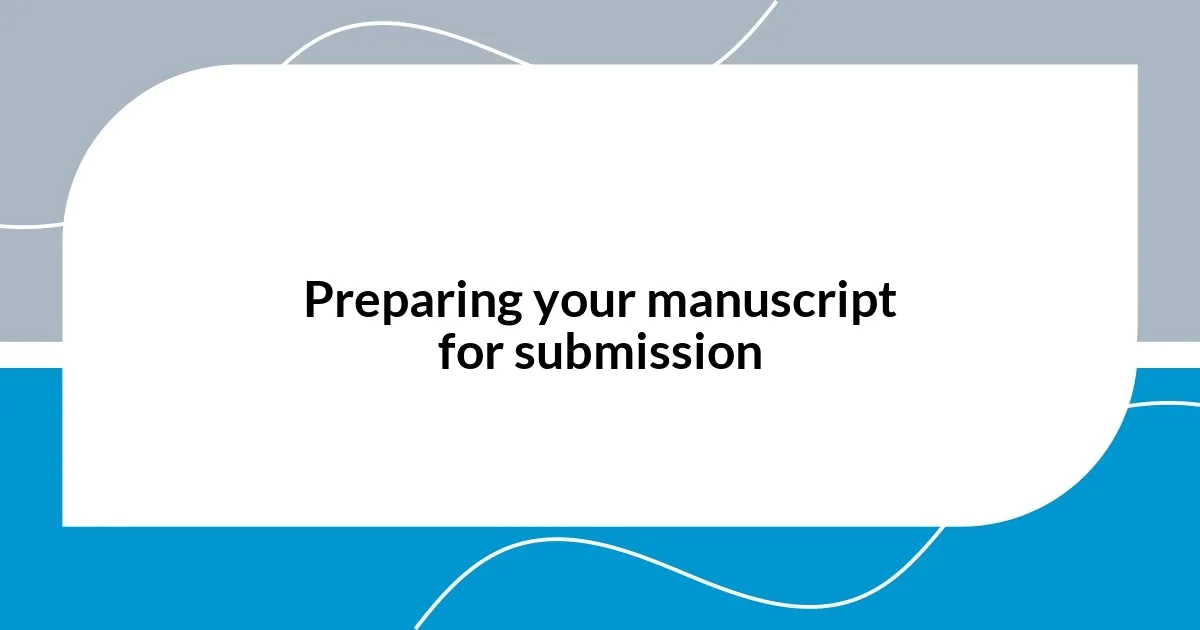
Preparing your manuscript for submission
Preparing your manuscript for submission is an intricate process, and I found this out firsthand while getting my own manuscript ready. I remember meticulously combing through the journal’s submission guidelines, noting details that I initially overlooked. Attention to detail can make a world of difference, as I discovered when I resembled a detective piecing together a puzzle—each element felt crucial to the whole.
Here are some key aspects to focus on while preparing your manuscript:
- Formatting: Follow the journal’s specific formatting requirements, including font size, margins, and citation style.
- Title and Abstract: Craft a concise and impactful title and abstract that encapsulate the essence of your work.
- Figures and Tables: Ensure that all visuals are clear, well-labeled, and comply with submission guidelines—this can enhance the presentation of your research.
- Cover Letter: Write a compelling cover letter that highlights your work’s significance and why it’s a good fit for the journal.
- References: Double-check that all references are complete and accurately formatted according to the journal’s style.
On my journey, I learned that each step, even if it felt tedious, had an important role in communicating the value of my work. I still recall the flutter in my stomach as I polished my cover letter, wanting the editor to see the passion and effort I had poured into my research. It’s these seemingly minor details that can help you stand out in a crowded field.
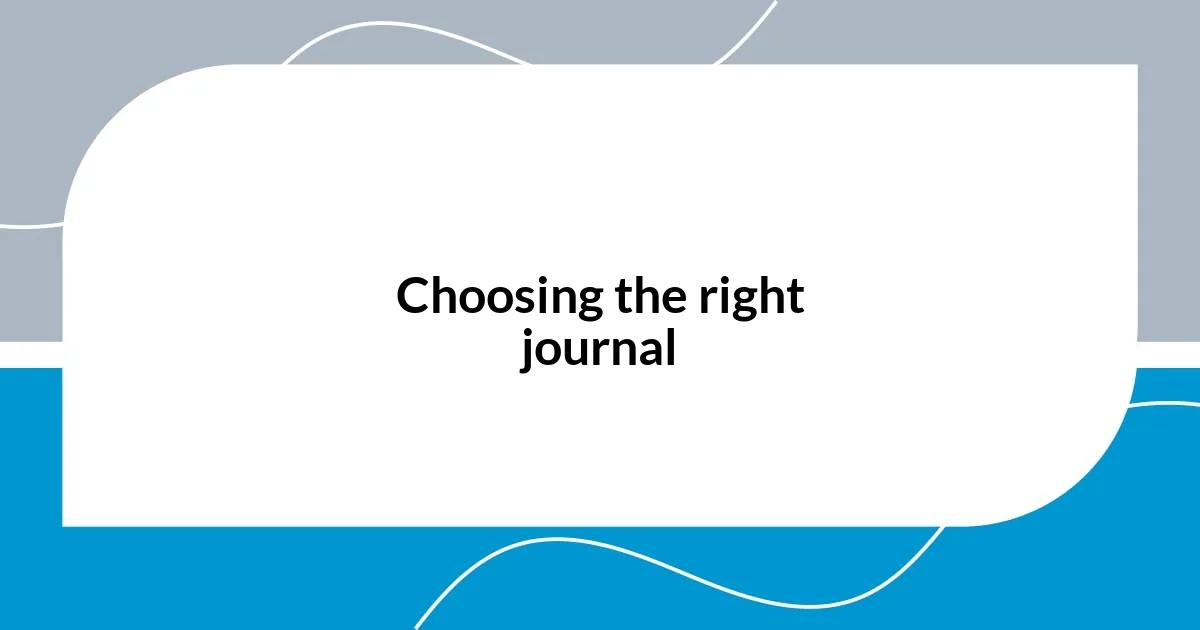
Choosing the right journal
Choosing the right journal can often feel like searching for a needle in a haystack. I remember scrolling through endless lists, feeling overwhelmed by the sheer number of options. Each journal seemed to promise a different readership and level of impact, making it challenging to pinpoint the best fit for my research. I realized that taking the time to align my work with the journal’s scope and audience could significantly increase my chances of acceptance.
In my case, I found it helpful to create a list of potential journals and evaluate their focuses, submission guidelines, and impact factors. This wasn’t merely a box-checking exercise; it required thoughtful consideration of where my work would resonate most. I vividly recall connecting with a colleague who had experience in the field. Their insights were invaluable; they guided me away from high-impact journals where my work might get lost amidst the noise, steering me toward more niche publications that welcomed my specific contributions.
Here’s a comparison of factors that I found helpful when choosing the right journal, displaying my thought process clearly:
| Factor | Considerations |
|---|---|
| Scope | Does the journal’s focus align with my research topics? |
| Audience | Will my target readers be actively engaged with this journal? |
| Acceptance Rate | What are the journal’s acceptance rates compared to its prestige? |
| Impact Factor | How does the journal’s influence align with my professional goals? |
| Review Time | What is the typical turnaround time for reviews in this journal? |
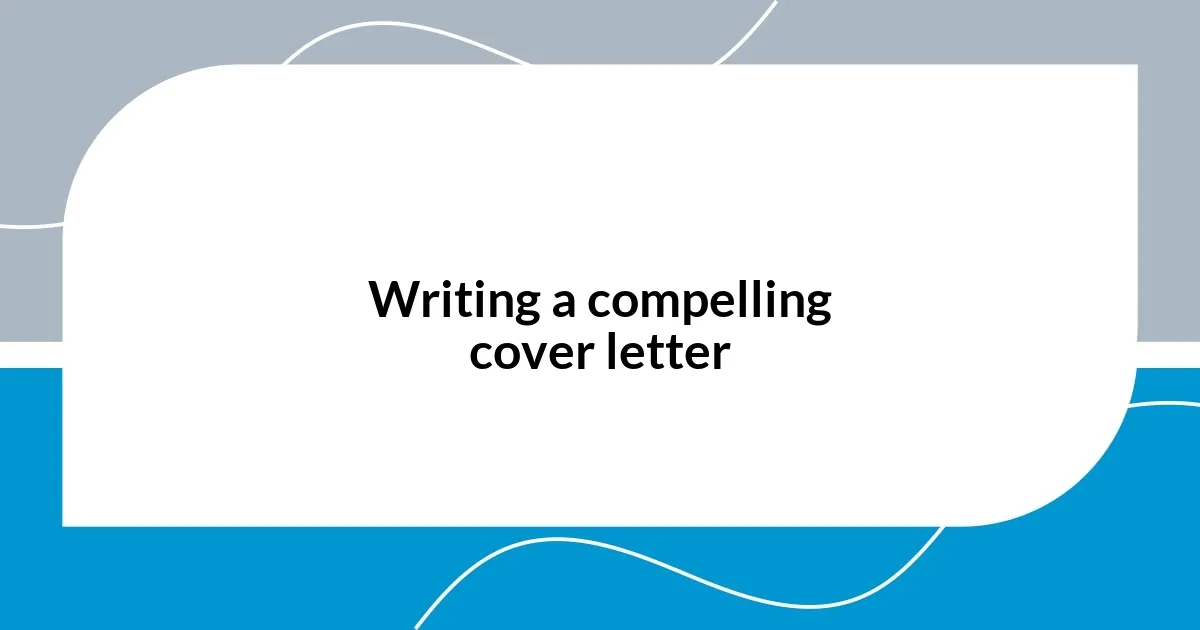
Writing a compelling cover letter
Writing a compelling cover letter is like shaking hands with the editor before your work even gets reviewed. I remember feeling a mix of excitement and trepidation as I composed mine, striving to convey the essence of my research without overwhelming with details. I found that starting with a strong opening sentence is crucial; it sets the tone and piques interest right away.
One angle I took was to emphasize the originality and significance of my work. I wanted to answer the unspoken question: why should this research matter to the journal? I wrote from the heart, highlighting not just my findings but the broader impact they could have. When I expressed why my work was a great fit for the journal, it was like connecting the dots between my passion and the journal’s mission.
Finally, I made sure to keep it concise and professional. A brief thank-you at the end felt personal, reminding me that the editor is a human being who appreciates a little gratitude. It’s amazing how such a small gesture can complement the formality of manuscript submission. Have you ever thought about how a cover letter can elevate the perception of your entire manuscript? In my experience, it truly does set the stage.
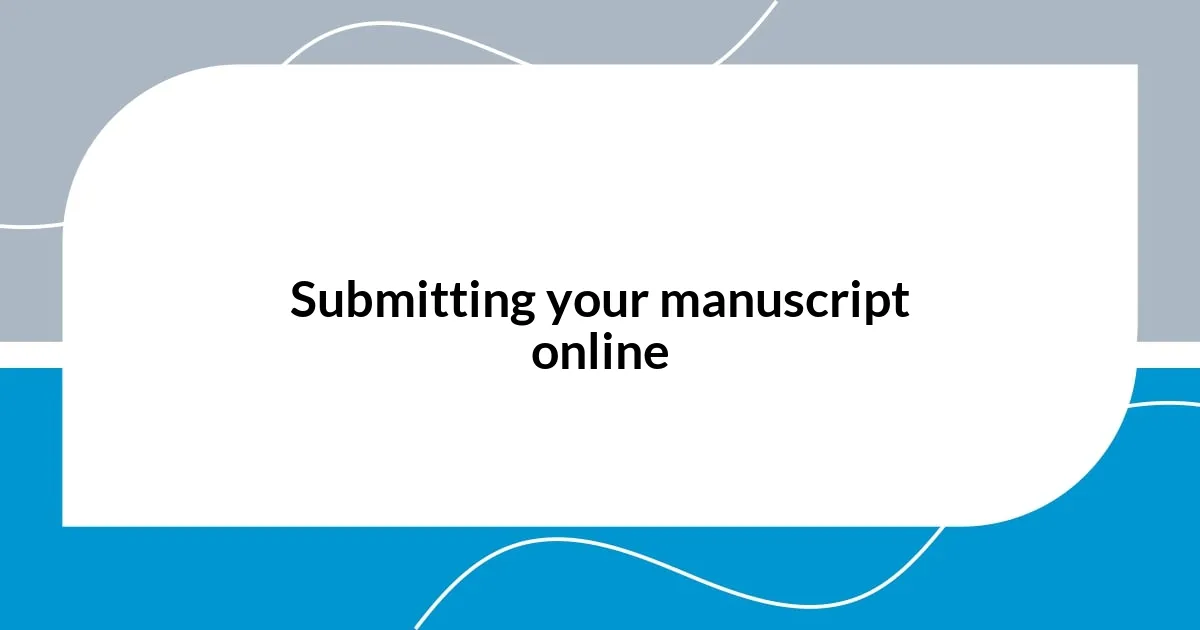
Submitting your manuscript online
Submitting your manuscript online can initially feel like stepping into uncharted territory. I distinctly remember my first submission day; my heart raced as I clicked that “submit” button. Each journal has its own platform, but universal features often guide you through the process, like filling in metadata about your manuscript, entering author details, and uploading your files. It’s almost like a game of checklist—did I remember everything?
One thing I learned was the importance of checking formatting requirements before submission. I once overlooked a simple guideline about font size, which resulted in a frustrating back-and-forth with the editors. It’s worth double-checking every detail, especially the file types and sizes allowed. Have you ever faced small errors at a critical moment? Those little things can feel like roadblocks when what you really want is to celebrate your progress.
Additionally, many submission systems will allow you to track where your manuscript is during the review process. This feature can be both a blessing and a curse. There were days when I found myself obsessively refreshing the page, almost willing it to change status. In hindsight, I wish I had embraced the waiting period more calmly. Patience is key in the academic world, and understanding that the review process takes time helps to keep anxiety at bay. This journey is not just about the submission—it’s about growth and learning along the way.
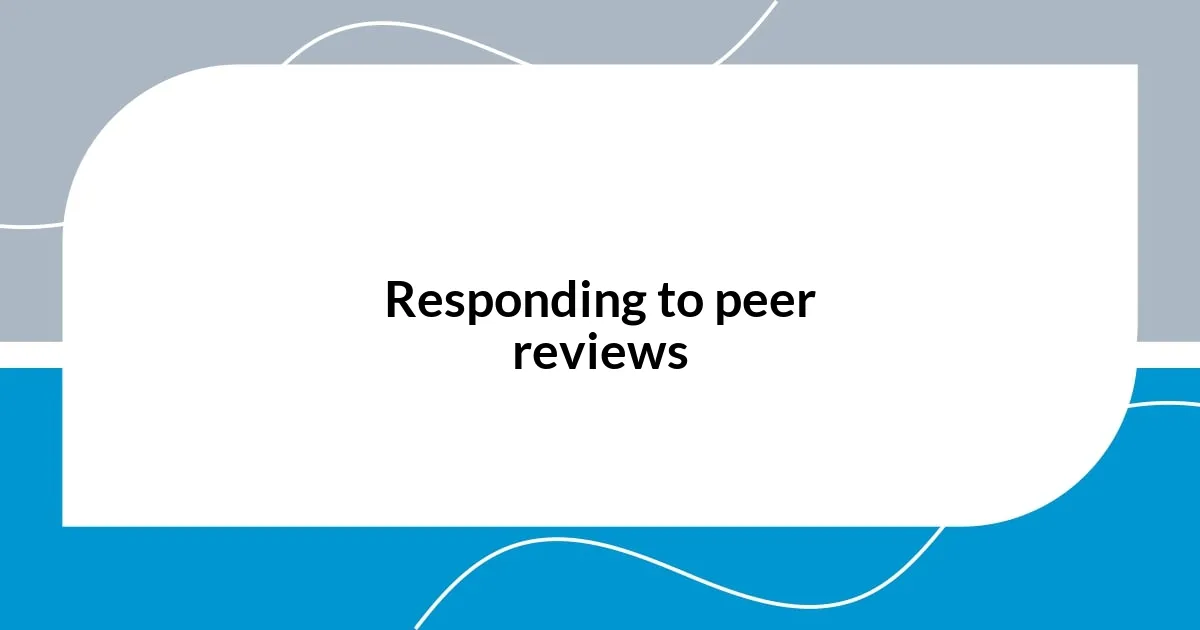
Responding to peer reviews
Responding to peer reviews can feel like navigating a maze—confusing, yet full of potential for growth. When I received my first set of reviews, I had a mix of relief and anxiety. The feedback was both insightful and critical, pushing me to scrutinize my work more closely. I remember staring at my computer screen, wondering how to balance my initial feelings of defensiveness with the valuable insights being offered. Have you ever felt that urge to justify every decision you made in your research? I realized that stepping back and viewing critiques as a pathway to refinement made all the difference.
When crafting my responses, I focused on being respectful and grateful, even for the harsher critiques. I vividly recall one reviewer pointing out a flaw in my methodology that I had sheepishly overlooked. Instead of bristling at the comment, I took a moment to reflect on it. This reflection allowed me to revise my manuscript in a way that genuinely strengthened my arguments. I found that acknowledging the reviewers’ hard-earned insights not only improved my work but also paved the way for constructive dialogue. Isn’t it funny how a few carefully chosen words can create a bridge instead of a wall?
The tone of my responses was equally important. I aimed to keep them professional yet personal. For instance, when addressing a suggestion for additional literature, I expressed my enthusiasm for the new sources, stating how they would enhance my narrative. I’ve learned that incorporating a touch of warmth, like sharing my genuine excitement for the revisions, can shift the dynamic in the review process. After all, we’re all on this journey of discovery together, striving to add value to the academic community. Wouldn’t you agree that collaboration, even through critiques, enriches our work?
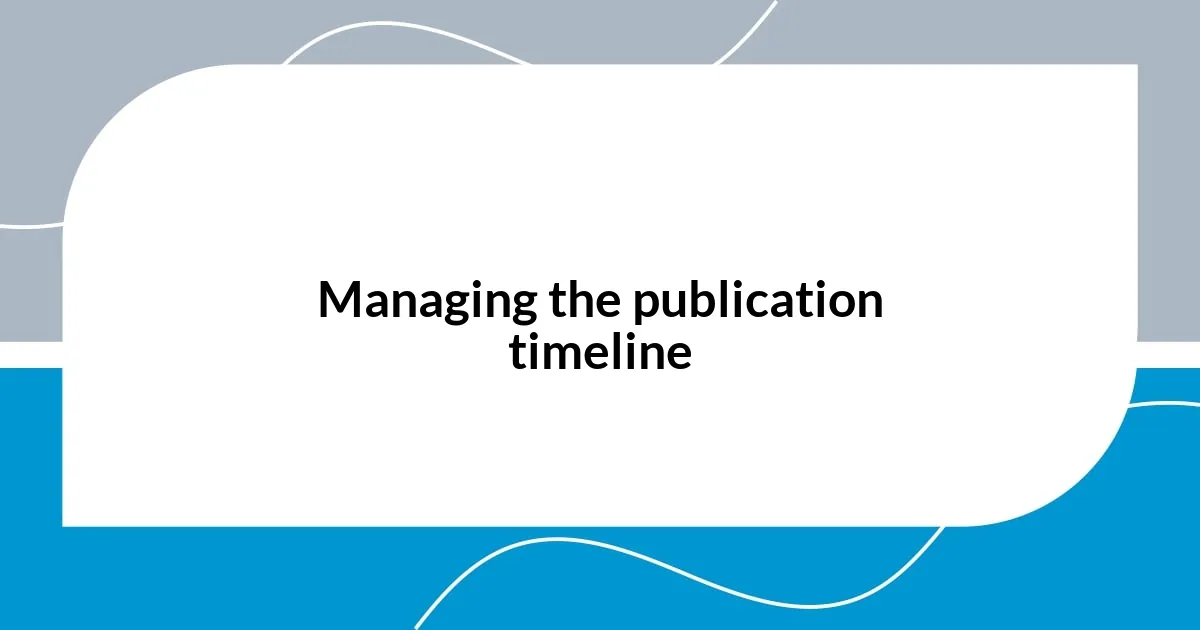
Managing the publication timeline
Managing the publication timeline requires careful attention and planning. I learned this the hard way when I first submitted my manuscript and underestimated the time it would take for review and revisions. To navigate this, I created a timeline with specific deadlines for each phase—submissions, responses to reviews, and final edits. It felt empowering to have a visual representation of my progress, but I still had to remind myself that flexibility is crucial; sometimes, life—and the publication process—throws unexpected curves at you.
One of the most eye-opening aspects of managing the timeline was realizing how much longer things take than I imagined. I remember staring at my calendar, eagerly anticipating the response from reviewers. Weeks turned into months, and while I know patience is a virtue, I sometimes felt like I was on an emotional rollercoaster. Have you ever felt that anticipation turn into uncertainty? I found solace in keeping busy with other projects during the wait, which helped ease the anxiety and keep my mind engaged.
Another lesson I gleaned from the process was the value of proactive communication. After a few months with no updates, I reached out to the journal to inquire about my submission’s status. I was pleasantly surprised by their prompt and friendly response, which alleviated my worries. This experience reinforced my belief that it’s not just about waiting passively; checking in can show editors that I was engaged and still enthusiastic about my work. Have you ever felt empowered just by taking that small step? It made me realize that managing the publication timeline isn’t only about the dates on a calendar; it’s also about maintaining a connection with the community you’re a part of.